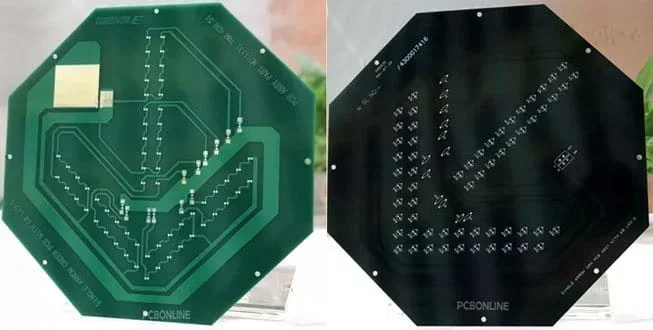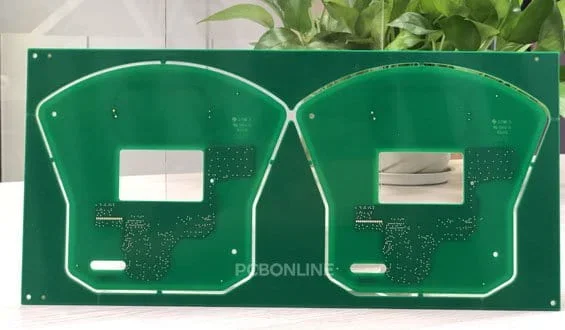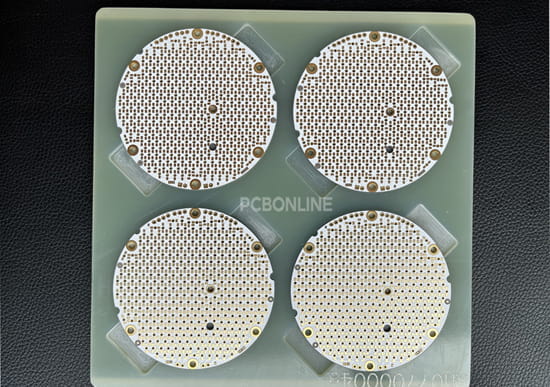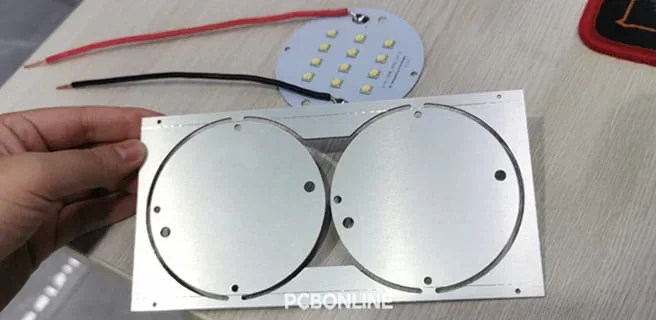Here, we will explain the basic knowledge of printed circuit boards (PCB) and types of PCBs as easily as possible. In this article, we plan to list many types of circuit boards in electronics.
![]()
Part 1. What is an Electronic PCB
PCB or printed circuit board is the backbone of practically all electronics. But it has long been more than just a conductor trace carrier. It is an electronic component that can do so much more than just connect electronic components.
To understand the types of PCBs, you need to understand their structure first. A PCB includes copper traces, the prepreg, and the core material.
Prepreg is a base material in which glass cloth is impregnated with resin (mostly epoxy) and cured to the B stage. Used for insulation between layers when molding the core material and copper foil of multilayer boards.
![]()
Copper-clad laminate is a material that is the base of board manufacturing also called CCL. Copper-clad laminates are made by impregnating glass cloth woven with highly insulating glass fiber with resin.
Now, you have a basic understanding of the PCB and its structure.
Let's see different types of PCBs.
Part 2. Three Types of PCB - Classified by Rigidness
The classification of types of circuit boards is based on their rigidness. Three types are as follows:
- Rigid PCB
- Flexible PCB
- Rigid-Flex PCB
![]()
A rigid and high-strength printed circuit board is called a rigid board. Rigid PCBs have hard materials, such as glass fiber/epoxy resin (FR4), ceramics, aluminum, copper, etc. So rigid PCBs have high strength and is easy to mount electronic components.
Flexible PCBA printed circuit board that uses flexible plastic film (polyimide (PI) or polyester (PET) ) is a flexible PCB, which is also called a "flexible printed circuit (FPC)". Since this type of printed circuit board can be bent, it is often used for moving parts of electronic devices.
Rigid-flex PCB

A rigid-flex PCB includes flexible PCB and rigid PCB layers. It is not simply connecting an FPC and an FR4 PCB but laminating the FR4 PCB layers on a flexible PCB by laser. Since rigid-flex PCBs can bend, have a small size, and save the PCB connector, it is used in compact spaces in electronics.
Part 3: Five Types of PCBs - Classified by Structure
Below are five types of circuit boards classified by the structure.
Single-sided boardOf electronic PCBs, the one with printing or electronic components mounted on only one side is a "single-sided PCB". This type of printed circuit board requires only one time of surface-mounting PCB parts during PCB assembly.
Double-sided PCB

A "double-sided board" has both sides printed and electronic components mounted on it. This type of electronic PCB is more suitable for forming a complicated electronic circuit than a single-sided board. It has the disadvantage that it costs more.
Single-layer PCBSingle-layer PCB is a type of circuit board that has only one circuit layer. Single-layer electronic PCB is not suitable for forming complex electronic circuits. It has significant advantages in terms of cost reduction.
Double-layer PCBDouble-layer PCB is a type of PCB that has two circuit layers. The two circuit layers can be on the same side of the substrate or separate on the two sides.
Multilayer PCB

A printed circuit board with 4, 6, or more circuit layers is a "multilayer PCB". Keep in mind that the circuit layer count of a multiple-layer electronic PCB typically is an even number. This is for the balance of the PCB structure.
The above is a general classification of types of PCBs. You may have heard of some advanced kinds such as high-frequency PCB, HDI PCB, and ceramic PCBs, which are not listed above. However, you can refer to PCBONLINE, which manufactures, designs, assembles, and provides one-stop customized services for all kinds of high-end PCBs.
Part 4. Different Types of PCB - Classified by the Substrate
The types of PCB boards can be broadly divided into:
- paper phenol PCB
- glass epoxy PCB
- composite substrates
- Teflon PCB
- ceramic PCB
- metal core PCB
A paper phenolic (FR1/FR2) board is made by hardening paper base material with a phenolic resin containing oil and fat. It has poor characteristics in heat and moisture resistance.
Although it is inferior to glass and epoxy in electrical characteristics and heat resistance, it is widely used for easy consumer electronic devices because of its low price.
Glass epoxy/FR4 PCB

Made of glass cloth impregnated with epoxy resin, this is the most common PCB in modern types of PCBs. Glass-epoxy (FR4) PCBs are used for circuits that require strength and insulation. Their dimensional change is small, and the insulation resistance is high.
For electronics, FR4 PCBs are the most used type of circuit board, and their production is the largest. It is used in personal computers, consumer electronic devices, office automation equipment, etc.
Glass composite PCBThis is a printed circuit board made of a material in which epoxy resin is impregnated into a base material. It is a mixture of glass cloth and glass nonwoven fabric (CEM-1 and CEM-3).
It has almost the same electrical characteristics as a glass/epoxy substrate. However, it has poor mechanical strength and dimensional stability. It is used less than FR4 circuit boards.
Teflon PCB

Teflon is the most famous brand for the material PTFE. So Teflon PCB is a PTFE PCB. This is a type of printed circuit board that uses Teflon resin as an insulating material.
Due to its excellent high-frequency characteristics, it is used in electronic devices that handle signals of several hundred MHz to several tens of GHz.
And we call all types of PCBs that can be used for high-frequency and high-speed applications "high-frequency PCB".
Ceramic PCBCeramic PCBs are not a type of circuit board but a general term for different types of ceramic PCBs, including alumina PCB and aluminum nitride (AlN)PCB.

An alumina PCB is a printed circuit board that uses a green sheet that is made by mixing aluminum oxide and a binder and sintering it.
An AlN PCB is a PCB that uses a gray-white sheet that is made by mixing aluminum nitride and a binder and sintering it.
A ceramic PCB is an electronic PCB characterized by excellent high-frequency characteristics.
The disadvantage is the high cost. It is used in microwave equipment, wireless communication base stations, and high thermal dissipation applications.
If a ceramic PCB is made by using the method of low-temperature co-fired ceramics, it is an LTCC PCB.
This makes it possible to perform simultaneous firing with a wiring pattern of low melting point material such as copper or silver built-in.
Perhaps this is the reason it is the favorite type of PCB among PCB manufacturers.
It is used as a substrate for high-frequency modules and semiconductor packages.
In addition, ceramic substrates such as hybrid ICs and SAW filters are sometimes used.
![]()
Metal-core PCBs include aluminum PCBs and copper-based PCBs. They have a metal substrate, so they have excellent characteristics in physical strength and thermal dissipation.

MCPCBs are widely used for LEDs and other high-thermal devices.
Manufacturer for All Types of PCB - PCBONLIE
Among the many types of PCBs, especially flexible boards are excellent in flexibility and may be built in the movable part of the product. If you are looking for excellent flexible boards, you can choose from PCBONLINE, which has more than 23 years of high-end PCB manufacturing experience.
PCBONLINE's PCB capability:
- PCB layer: 1 ~ 42
- Laminate material: FR4, ceramics, aluminum, copper, PTFE/Teflon, PI, and PET
- Surface finishing: OSP/HASL/LF HASL/immersion ENIG/immersion tin/immersion silver
- Board thickness: 0.15mm ~ 3.2 mm
- Max board size: 500 × 580 mm
- Copper thickness: (inner finish copper) 1-7oz, (outer finish copper) 1-14oz
- Min. line width/spacing: 0.0635 mm/0.0635 mm
- Min. CNC drilling size: 0.15 mm
- Min. laser drilling size: 0.075 mm
- HDI stack up: 1+N+1, 2+N+2, 3+N+3, 4+N+4

The source factory PCB manufacturer PCBONLINE provides all types of PCBs as you quote for. All types of PCBs it fabricates and assembles are certified with ISO, IATF, REACH, RoHS, and UL standards. By working with PCBONLINE, you can get one-on-one engineering support throughout your PCB project and the best-quality PCB boards.
Conclusion - Expanding demand for printed circuit boards in the world
This time, we explained the roles, types of PCB, merits, and structures of printed circuit boards that are used almost exclusively in electronic devices.
Printed circuit boards can be classified into many types based on their characteristics and processing methods. Simultaneously, in the future, small high-performance electronic devices will be developed around the world by further utilizing these characteristics.
The above is our classification of the different types of PCBs. If you want to know more about the advanced types or need a high-end PCB for manufacturing your items, check PCBONLINE.
You may also read:




